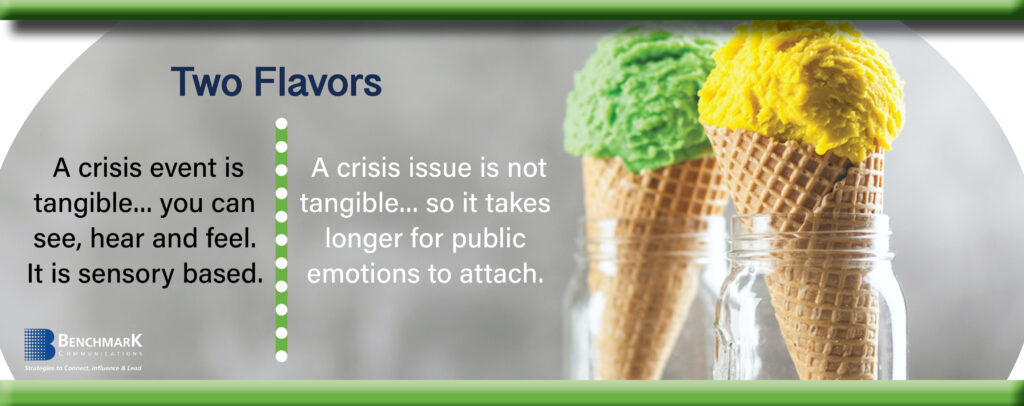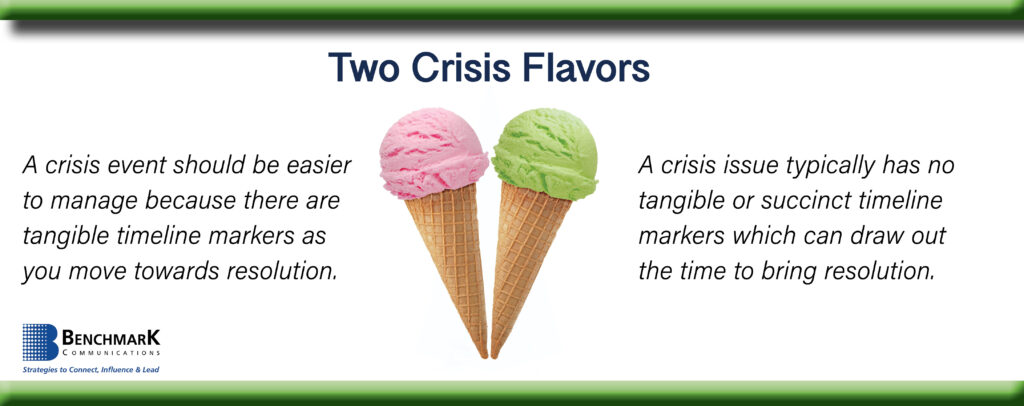The COVID-19 pandemic was a wakeup call for organizations that have neglected their crisis plans and preparedness levels. A worldwide survey conducted just one year before the pandemic hit revealed that 95% of leaders believed they would face a significant crisis within two years. As a follow up, only 35% of those leaders said they had “very relevant” crisis plans to help them cope with the challenges of the global shutdown. This should serve as a warning for organizations to take time now to renew their commitment to creating relevant and actionable crisis plans.
Crisis Plan Refinement
There are many elements that go into an effective crisis plan. One crucial element is identifying the key risks your organization will most likely face. In recent years our team at Benchmark Communications has refined this particular crisis plan element to include another step: categorizing those risks by Event or Issue. As we like to say, “A crisis comes in one of two flavors – an Event or an Issue”. Here are some key things to know about the difference between these crisis flavors.

1. Crisis Flavors: Key Differences
A crisis Event is tangible. You can typically see it, hear it or feel it. it is sensory based. It results in immediate emotions by those who experience or witness it. Some examples of crisis Events include the following: protests, fires, explosions, natural disasters such as hurricanes, transportation disasters, power outages, layoffs, workplace violence, oil spills, gas explosions, food recalls, etc.
On the other hand, a crisis Issue is not typically loaded with the tangible elements. The following are examples of crisis Issues: product safety investigations, reports of corporate fraud, major price hikes, and product tampering charges. Other examples of Issues include activist or whistleblower claims, price gouging allegations or corporate policies that are deemed harmful to employees or the public.
2. Crises and the Impact of Emotions
Public emotions are key drivers of media coverage and stakeholder reactions during a crisis Event. The higher the emotions, the more media coverage and social media buzz. It also influences stakeholder involvement and overall fallout. The display of public emotions is more immediate with a crisis Event. This happens because people react to the visuals of what they see and feel about the Event. Therefore, an Event calls for a very different approach in your crisis plan and response within the first 48 to 72 hours. Too many organizations fail to correctly calibrate the level and importance of public emotions. In turn, they miss the mark with their response and tone.
- I often think of United Airlines sending security officers to forcibly remove the passenger several years ago. It was a tangible crisis Event. Thanks to cell phone cameras of other passengers, aka citizen journalists, we saw the man’s bloody nose and slumped body as they forcibly removed him from the plane. That Event went viral, and the outrage was immediate across social media. Anger is the emotion that makes stories go viral! The United CEO completely missed the mark in his first media response and United paid the price.
Emotions also play an important role in a crisis Issue, but they do not tend to erupt so quickly. Therefore, a different response strategy is required and should be considered in your crisis plans. With most crisis Issues your organization has more time to analyze the possible emotional levels before the story picks up steam. Of course, this hinges on your risk assessment capabilities. It also hinges on the philosophy of your crisis leaders. With the right assessment models in place you can create a well-calibrated response to public emotions and expectations.

3. Which “Crisis Flavor” is Harder to Manage?
A Crisis Event is typically easier to address than an Issue because there are tangible timeline markers for the media and public to witness. If your organization has an effective crisis plan that satisfies those timeline markers, then emotions subside more quickly. In turn, this allows the organization to move more quickly towards a resolution.
- Take for example a fire at a manufacturing facility; if a good operational response plan is in place then the fire will be extinguished within a manageable timeframe. The same is true for product recalls. A company will announce the recall and communicate the necessary actions to address the Event. Of course, there will always be residual fallout in any crisis. That fallout can take weeks, months and even years to completely satisfy and address.
On the other hand, with a crisis Issue there are typically no succinct or tangible timeline markers. By their very nature these types of crises involve things that often result in lengthy timeframes. This includes things such as investigations, corporate fraud charges, public rumor, social media gossip, regulatory reviews and other things. The truth is that most crisis Issues will not be resolved within a short timeframe.
- A great example of a Crisis Issue is the prolonged public and medical debate about the adverse health impact of sugary and diet soda consumption. Beverage groups like Coca Cola and Pepsi cannot control the negative narratives about the health detriments of their products. So, year after year they continue to lose market share on many of their heritage beverages. Health and fitness bloggers have inundated social media with memes to alarm Americans about he downsides of sugary and diet sodas. There is not much beverage groups can do to fight those emotions or change the drawn-out timeline.
4. Can a Crisis Event Morph Into a Crisis Issue?
It is common for a crisis Event to morph into an Issue and vice versa! When this happens, your organization must change its response strategies to cope. An example of a hot crisis Issue right now is the debate over whether companies can require employees to take the COVID-19 vaccine.
At Methodist Hospital in Houston, Texas more than 150 employees formed picket lines to protest the hospital requiring employees to take the vaccine. The employees argued the vaccines are experimental and their employer had no right to demand they take it. The outcome was that many of them were fired or resigned after they lost their first battle in court. But the hospital workers opened a huge debate for employees across the nation and the world. In recent weeks huge demonstrations have erupted across the globe about this topic.
- The Methodist Hospital crisis sequence went like this: a) It was an internal Issue as employees learned the organization would require the vaccine b) It morphed into a tangible crisis Event in the form of an employee picket line outside of the hospital and c) It morphed back into an Issue that is influencing more employees and organizations across the country and globe.

The Wake-Up Call for Crisis Plans
The COVID-19 pandemic is a huge wake-up call for many organizations that have neglected their crisis plans. Our crisis consulting team has witnessed organizations of all sizes suffer the consequences of having ineffective crisis plans. You may remember after the catastrophic BP oil spill in the Gulf of Mexico, many prominent CEO’s of the big oil companies got mud on their faces during congressional hearings about oil spills. Congress subpoenaed their crisis plans and accused them of using the same plans! One lawmaker said, “It looks like you all just used a copying machine and used the same plan that includes the same crisis consultant that has been dead for years.” The bottom line is you need actionable and relevant crisis plans in place that are customized to your specific operations.
Training Your People to Respond
Many crisis plans are cumbersome and even confusing, making them irrelevant when a real crisis occurs. You must build awareness of key crisis strategies and processes across your crisis response team. Solid crisis strategies and processes within your crisis plan will allow your people to make timely assessments. Then, they can take appropriate actions! It can make all the difference in the world – when the world appears to be turned upside down!
Ask For Help!
If your organization needs help updating your crisis plans, or putting effective training into place to prepare your crisis teams and leaders – we can help! We offer actionable and relevant consulting, training and coaching for leaders and teams. CONTACT US to explore your business goals and options. Take care and be safe!

